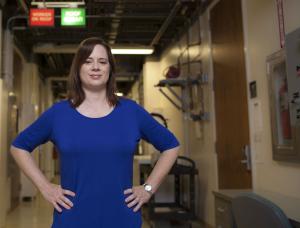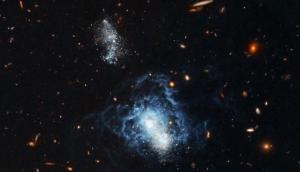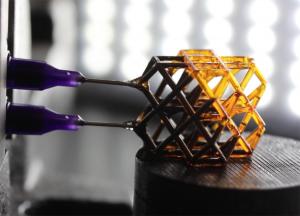LAB REPORT
Science and Technology Making Headlines
Feb. 1, 2019


A team lead by LLNL Associate Program Leader in Energy Infrastructure Liang Min (left, with researcher Philip Top) will move on to perform transmission and distribution co-simulation using HELICS, a tool developed by the Department of Energy’s Grid Modernization Lab Consortium. Photo by Randy Wong/LLNL.
Girding the grid for modernization
A Lawrence Livermore team has successfully deployed a widely used power distribution grid simulation software on a high-performance computing (HPC) system, demonstrating substantial speedups and taking a key step toward creating a commercial tool that utilities could use to modernize the grid.
Partnering with power management company Eaton to use its CYME software on LLNL’s HPC Quartz system, researchers were able to run thousands of simulations in parallel across 100 core computations. This was accomplished faster than previously possible, which could enable utility companies to better plan energy distribution and simulate the impact of renewable energy resources on the entire electrical grid.
“Essentially, we showed we can run 100 circuits in parallel, and it will take the same time as a single circuit,” LLNL researcher Vaibhav Donde said. “But 100 is not a magic number. We have much more capability than that at the Lab, so we can run thousands or maybe more of those scenarios in parallel and achieve a similar order of performance. It opens up the possibility of what we can do in the future and may transform how utilities plan the future grid.”


LLNL chemist Dawn Shaughnessy and her team discovered six elements on the periodic table.
A woman in her element
The story of how dozens of elements were corralled into a periodic table reaches beyond one person and one point in time. Scientists classified and predicted elements before and after Dmitri Mendeleev’s 1869 framework. And many more worked to find and explain these new substances. Noble gases, radioactivity, isotopes, subatomic particles and quantum mechanics were all unknown in the mid-19th century.
But many of those discoveries were conducted by women who revolutionized our understanding of the elements. One of those women is LLNL’s Dawn Shaughnessy, who along with her team, discovered six new elements (113-118), the heaviest elements on the periodic table.
Shaughnessy was trained by U.S. chemist Darleane Hoffman who made a monumental leap in the early 1970s. She showed that the isotope fermium-257 could split spontaneously — not only after being bombarded with neutrons. Hoffman also uncovered plutonium-244 in nature. She trained generations of female scientists.
Shaughnessy is now principal investigator of the heavy-element project) at Lawrence Livermore.


The most direct prediction of Big Bang nucleosynthesis concerns helium-4, a standard product of stellar nuclear fusion. To infer the primordial helium-4 amount, astronomers turn to certain dwarf galaxies. This image shows an important example, the galaxy "I Zwicky 18." Image courtesy of NASA.
Peering into the origins of the universe
Using simulations and calculations, Lawrence Livermore nuclear scientists for the first time have accurately predicted the properties of polarized thermonuclear fusion. Analogous calculations could be used to answer some of the most fundamental questions about the origins of the universe and the evolution of stars.
For decades, nuclear scientists have been trying to harness the energy produced by the thermonuclear fusion of some of the lightest nuclei, deuterium (D) and tritium (T), to power thermonuclear reactors of the future.
In spin polarized DT thermonuclear fusion — where the D and T nuclei are "spinning" in the same direction —the fusion rate could be enhanced by as much as 50 percent and the produced charged helium (He) nuclei could be more efficiently focused to heat up the fuel. This is one of fusion technology's next frontiers.
Thermonuclear fusion occurs naturally in stars, which — from birth to death — are fueled by nucleosynthesis, and also plays an important role in explaining the primordial abundances of elements after the Big Bang. Because of this, thermonuclear reactions are of great interest to astrophysicists who seek to answer some of the most fundamental questions about the origins of the universe and the evolution of stars.


Carbon capture micocapsules sitting on a quarter for scale.
Baking staple key to carbon capture
Although the use of renewable energy is on the rise, coal and natural gas still represent the majority of the United States energy supply. Burning these fossil fuels for energy releases a tremendous amount of carbon dioxide into the atmosphere -- in the U.S. alone, coal and natural gas contributed 1,713 million metric tons of CO2, or 98 percent of all CO2 emissions from the electric power sector in 2017. In an effort to mitigate these effects, researchers are looking for affordable ways to capture carbon dioxide from power plant exhaust.
Research led by Lawrence Livermore National Laboratory and the University of Pittsburgh uses microcapsule technology and baking soda that may make post-combustion carbon capture cheaper, safer and more efficient.
The approach is very different than the traditional method of capturing carbon dioxide at a power plant. Instead of flowing a chemical solvent down a tower (like water down a waterfall), the team is putting the solvent into tiny microcapsules. Similar to containing liquid medicine in a pill, microencapsulation is a process in which liquids are surrounded by a solid coating.


Researchers injected a magnetorheological fluid into hollow lattice structures built on LLNL’s Large Area Projection Microstereolithography platform, which 3D prints objects with microscale features over wide areas using light and a photosensitive polymer resin.
As quick as a flash
While additive manufacturing (AM) lets engineers and scientists build parts in configurations and designs never before possible, the impact of the technology has been limited by layer-based printing methods, which can take hours or days to build three-dimensional parts.
But by using laser-generated, hologram-like 3D images flashed into photosensitive resin, researchers at Lawrence Livermore, along with academic collaborators, have discovered they can build complex 3D parts in a fraction of the time of traditional layer-by-layer printing. With this process, researchers have printed beams, planes, struts at arbitrary angles, lattices and complex and uniquely curved objects in a matter of seconds.
“The fact that you can do fully 3D parts all in one step really does overcome an important problem in additive manufacturing,” said LLNL researcher Maxim Shusteff. “We’re trying to print a 3D shape all at the same time. The real aim is ‘can we make arbitrary 3D shapes all at once, instead of putting the parts together gradually layer by layer?’ It turns out we can.”





